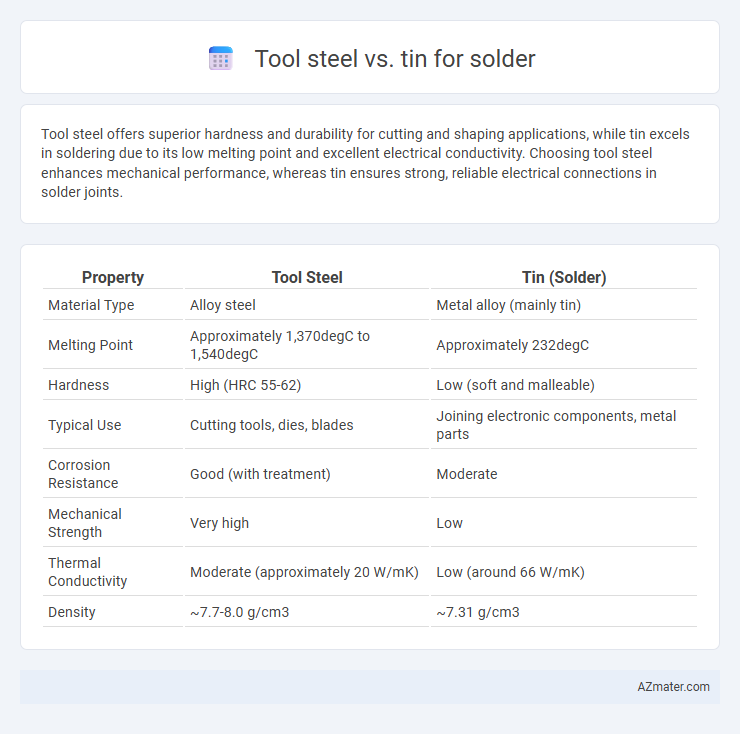Tool steel offers superior hardness and durability for cutting and shaping applications, while tin excels in soldering due to its low melting point and excellent electrical conductivity. Choosing tool steel enhances mechanical performance, whereas tin ensures strong, reliable electrical connections in solder joints.
Table of Comparison
| Property | Tool Steel | Tin (Solder) |
|---|---|---|
| Material Type | Alloy steel | Metal alloy (mainly tin) |
| Melting Point | Approximately 1,370degC to 1,540degC | Approximately 232degC |
| Hardness | High (HRC 55-62) | Low (soft and malleable) |
| Typical Use | Cutting tools, dies, blades | Joining electronic components, metal parts |
| Corrosion Resistance | Good (with treatment) | Moderate |
| Mechanical Strength | Very high | Low |
| Thermal Conductivity | Moderate (approximately 20 W/mK) | Low (around 66 W/mK) |
| Density | ~7.7-8.0 g/cm3 | ~7.31 g/cm3 |
Introduction to Tool Steel and Tin in Soldering
Tool steel, known for its high hardness and resistance to abrasion, is primarily used in cutting and shaping applications rather than soldering. Tin, a soft metal with excellent wetting properties, is a critical component in solder alloys, enabling strong, conductive joints by melting at relatively low temperatures. In soldering, tin's role ensures effective bonding and electrical conductivity, whereas tool steel serves structural purposes in manufacturing tools used during assembly processes.
Chemical Composition: Tool Steel vs Tin
Tool steel primarily consists of iron with carbon (typically 0.5-1.5%) and alloying elements such as chromium, molybdenum, tungsten, and vanadium, enhancing hardness and wear resistance. Tin used for solder is predominantly composed of over 99% tin, sometimes alloyed with small amounts of silver, copper, or lead to improve melting point and ductility. The key chemical difference lies in tool steel's complex alloy matrix designed for structural durability versus tin's nearly pure metallic composition optimized for low melting temperature and electrical conductivity.
Physical Properties Comparison
Tool steel exhibits high hardness, tensile strength, and wear resistance, making it ideal for cutting and shaping tools, while tin for solder is characterized by low melting point, excellent ductility, and good corrosion resistance essential for creating reliable electrical joints. Tool steel typically has a melting point above 1300degC, whereas tin solder melts around 232degC, enabling easy fusion of metal components without damaging sensitive parts. The density of tool steel ranges around 7.8 g/cm3, contrasting with tin's lower density near 7.3 g/cm3, influencing weight considerations in application design.
Melting Points and Thermal Conductivity
Tool steel has a high melting point ranging from 1,370degC to 1,540degC, making it suitable for applications requiring significant heat resistance, whereas tin melts at a much lower temperature of 232degC, ideal for soldering tasks. The thermal conductivity of tool steel typically falls between 20-30 W/m*K, providing moderate heat transfer, while tin offers a lower thermal conductivity around 67 W/m*K, facilitating controlled heat flow in electronic solder joints. These differences make tool steel effective for durable tooling and high-temperature conditions, whereas tin is preferred for efficient, low-temperature soldering applications.
Durability and Wear Resistance
Tool steel excels in durability and wear resistance compared to tin used in solder, due to its high carbon content and alloying elements like chromium and vanadium that enhance hardness and toughness. Tin solder, while ideal for creating electrical connections because of its low melting point and good conductivity, lacks the mechanical strength and abrasion resistance found in tool steel. Consequently, tool steel is preferred in applications requiring prolonged mechanical stress and wear, whereas tin solder suits primarily delicate electronic assembly tasks.
Corrosion Resistance: Which Material Lasts Longer?
Tool steel offers superior corrosion resistance compared to tin, making it more durable in harsh environments where moisture and chemicals cause degradation. Tin, commonly used in solder, corrodes more quickly under prolonged exposure to humidity and flux residues, leading to weaker joints and potential failure. Therefore, tool steel components generally last longer than tin-based solders when corrosion resistance is a critical factor.
Solderability and Joint Strength
Tool steel offers superior joint strength compared to tin due to its hardness and resistance to deformation, making it ideal for mechanical stability in soldered assemblies. Tin typically provides better solderability because of its low melting point and excellent wetting properties, facilitating smooth solder flow and strong metallurgical bonds. However, the choice between tool steel and tin depends on balancing the need for mechanical durability against ease of soldering and corrosion resistance in specific applications.
Cost and Availability
Tool steel is significantly more expensive and less readily available compared to tin, which is widely produced and cost-effective for soldering applications. Tin's abundant global supply and lower raw material cost make it the preferred choice for solder manufacturing, especially in large-scale electronics production. Tool steel's higher cost and limited availability restrict its use mainly to specialized industrial tools rather than solder.
Typical Applications in Soldering
Tool steel is primarily used in soldering applications requiring strong, durable fixtures and precise tooling components, such as custom jigs and soldering tips due to its high hardness and wear resistance. Tin-based solder, by contrast, serves as the actual bonding material in electronics assembly, ideal for joining electrical components and circuit boards because of its excellent wetting properties and low melting point. Typical applications for tool steel include the manufacture of soldering iron tips and fixtures, while tin solder is essential for creating reliable electrical connections in consumer electronics and automotive wiring.
Choosing the Right Material: Tool Steel or Tin?
Tool steel offers superior hardness and wear resistance, making it ideal for applications requiring high durability and strength, while tin excels in soldering due to its excellent electrical conductivity and low melting point. Selecting the right material depends on whether mechanical strength or efficient thermal and electrical bonding is the priority. For precision solder joints, tin-based alloys ensure reliable conductivity, whereas tool steel serves better in structural components exposed to mechanical stress.

Infographic: Tool steel vs Tin for Solder
 azmater.com
azmater.com